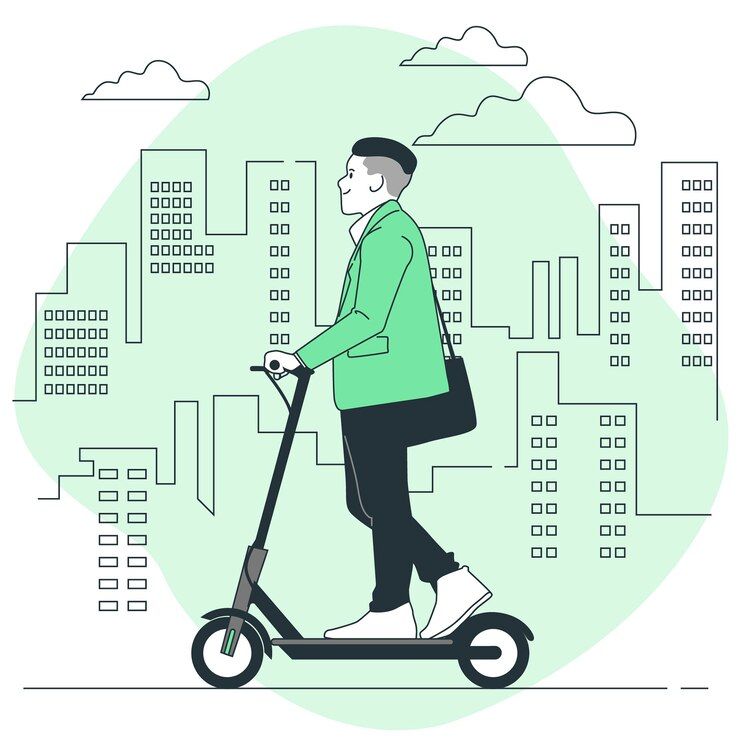
How to Increase Battery Life of Electric Scooter? A Comprehensive Guide
In this guide, we'll delve into the ins and outs of charging your electric scooter, covering everything from how to charge your electric scooter and where to charge your electric scooter to maximizing battery life and addressing common concerns. If you are interested, keep reading!
 How to Charge Your Electric Scooter?
How to Charge Your Electric Scooter?
Let's kick things off with the basics—how to charge your electric scooter. It's a simple process, but a crucial one. Start by locating the charging port on your scooter. It's typically near the deck or under the footboard. Once found, connect the charger provided by the manufacturer. If your scooter comes with a removable battery, you might also have the option to charge it separately. Ensure a secure connection and plug the charger into a standard electrical outlet. Most electric scooters come with indicators to show the charging status. When the battery is fully charged, unplug and hit the streets with confidence.
Where to Charge Your Electric Scooter?
Finding the perfect charging spot is pivotal for hassle-free rides. Most urban areas are equipped with charging stations dedicated to electric scooters. Look for these stations near public spaces, parks, or transportation hubs. If you're charging at home, a garage or any secure area with access to a power outlet will suffice. Charging at work? Check if your workplace has designated charging areas or seek permission to plug in at a convenient spot.
How Long to Charge an Electric Scooter?
The general statistics on electric scooter charge times reveal a landscape of variability. On average, the charging process takes about five and a half hours, showcasing the efficiency of modern charging technologies. However, this duration can be as swift as three hours, demonstrating the rapid-charging capabilities present in many electric scooter models. The charging timeline is influenced by factors such as the type of battery a scooter possesses and whether it's completely depleted before plugging in. While the usual charging timeframe hovers under eight hours, it's essential to note that a scooter with a dead battery may necessitate double the standard time for a full charge.
Can I Charge My Electric Scooter Overnight?
The burning question—Can I charge my electric scooter overnight? In most cases, yes. Modern electric scooters, including those from JOYOR, often come equipped with advanced battery management systems that prevent overcharging. However, it's essential to use the charger provided by the manufacturer and follow their guidelines for safe charging practices. Charging your scooter overnight is convenient, ensuring you start each day with a fully charged battery. For added peace of mind, consider using a smart plug or timer to automatically turn off the charger once the battery is full.
 How Long Does an Electric Scooter Charge Last?
How Long Does an Electric Scooter Charge Last?
Now that your scooter is charged and ready to roll, let's talk about how long that charge will last. The range varies based on factors like battery capacity, rider weight, terrain, and speed. On average, electric scooters offer a range of 15-30 miles on a single charge. High-performance models from JOYOR often push those limits, providing an extended range for your commuting needs. To maximize your scooter's range, adopt smooth acceleration and avoid unnecessary heavy braking. Regular maintenance, like keeping your tires properly inflated and the scooter well-lubricated, can also contribute to better efficiency.
How to Increase Battery Life of Electric Scooter?
Optimizing the lifespan of your electric scooter's battery is a journey of smart practices and mindful charging. Here's a comprehensive guide to ensure your electric scooter stays charged and ready for the road:
1. Calculate Your Average Range
Understanding your scooter's battery capacity is the first step. Consult the scooter manual or the manufacturer's website for battery specifications and estimated ranges. These ranges are typically calculated under specific conditions, so your daily variables like weight, speed, and road incline will affect your range. Keep track of your travel details to gauge your battery's capacity based on your riding style.
2. Don't Drain the Battery
Avoid fully draining and fully charging your battery, especially when it's new. While it's recommended for the first three cycles, ideally, you shouldn't let your battery drop below 40%. Strive to charge it when it's between 10% and 40% for optimal battery health. Remember, the average lifespan of a battery is between 500 and 800 cycles, so preserving its charge is crucial for long-term performance.
3. Use the Right Charger
Stick to the original charger that comes with your electric scooter. While aftermarket chargers may seem tempting, they might damage the battery. Ensuring you have the right charger is a simple yet effective way to maintain your battery's health.
4. Store It in the Right Conditions
When not in use, store your scooter in a dry environment with a constant temperature between 10-30 degrees Celsius. Avoid direct sun exposure, extreme temperatures, and constant temperature changes, as these factors can significantly impact the battery's life. If you plan on not using it for an extended period, charge it at least once a month, maintaining the battery percentage between 50% and 80%.
Conclusion
In conclusion, mastering the art of charging your electric scooter is a fundamental skill for every rider. From understanding the charging process to optimizing battery life, and even exploring alternatives, you're now equipped with the knowledge to keep your electric scooter running smoothly. And with JOYOR by your side, every ride becomes an exhilarating journey into the future of urban mobility. Happy riding!
